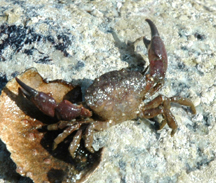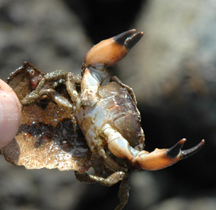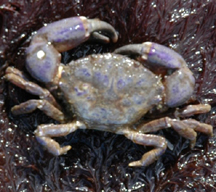
![]()
Black-clawed Crab
(Lophopanopeus bellus)
Other Names: Black-clawed Mud Crab, Black-clawed Pebble Crab, Black-clawed Shore Crab.
Photo 1: View of carapace and extended claws.
Unlike other shore crabs that scuttle away as soon as you flip over a rock, this feisty little crab is as likely to extend its claws in a threatening posture. This characteristic makes it a photographer's ideal subject since it presents a steady target in pose. (Taken at Shelter Point Reef).
Photo 2: Underside of crab showing coloration.
This photo shows how the black-clawed crab gets its name. The black coloration is clearly visible against the lighter colored underside. (Taken at Shelter Point Reef).
Photo 3: Profile view of crab.
Claws extended right to the end of our encounter. The crab scurries down the rock and away to safety. (Taken at Shelter Point Reef).
Photo 4: Purple variation of black-clawed crab.
The purple coloration of this crab can lead to a misidentification as a purple shore crab. However, this purple variant of black-clawed crab is just as feisty. Identification can also be made by looking at the teeth on the carapace1. Black-clawed crabs have three easily identifiable teeth at each front corner of their carapaces. Unfortunately, these teeth are hard to make out in these photos, but if you look closely you can see them, albeit not clearly, in photos 1 and 4. (Taken at Shelter Point Reef).




(1) Teeth on a carapace are bumps or sharp jutting bits. Carapace teeth can be very helpful in identification of species both living and extinct.
Other Pacific Northwest Crabs: Red Rock Crab, Kelp Crab, Porcelain Crab
